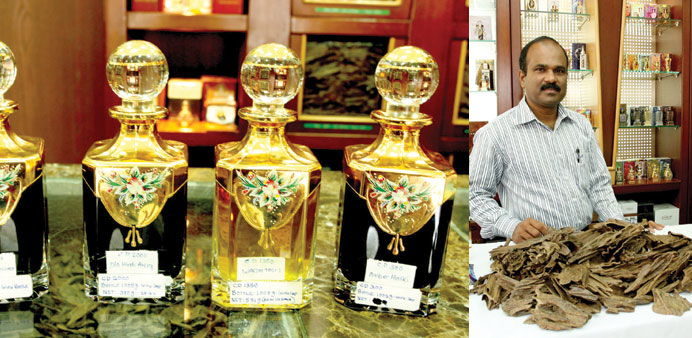STARRING OUD: A variety of pure oud oils to pamper to different tastes. Right: OUD PROFICIENT: Saidalavi, Company Supervisor of Al Haramain Perfumes. Photos by Nasar T K
By Aney Mathew
Who would have thought that one of the world’s most expensive, natural, raw materials would be a resin-embedded heartwood, formed when certain evergreen trees come under fungal attack? Or that it is indeed a product resulting from the wound of an infected tree? What’s more? The greater this infection in the Aquilaria tree, the more superior the product!
If you’ve lived in the Gulf even for just a few years, chances are you’ve been introduced to the fragrance of agarwood locally known as oud, or its derivatives — at some point. For the uninitiated on local perfume preferences, here’s some jaw-dropping information — the costliest agarwood is priced about US$30,000 per kilo!
Considered more precious than even gold by weight, pure oud oil extracted from agarwood is usually the perfume of choice in the Arab world, especially among the older generation. In Yemen, a gift of oud is an expected part of the dowry that the bride receives from the groom. Agarwood and its many derivatives have been a much-traded item in the Arab-speaking world for over 2,000 years, being sourced from both India and further east in South-east Asia.
Popularity of this prized product is recorded with interesting anecdotes in history. It is believed that King Louis XIV of France, who indulged in some extreme practices of luxury, had his clothes washed in oud. Another intriguing piece of information reveals that extremely wealthy, ancient Chinese used to make their coffins out of agarwood. The rich smell of oud oil has so caught the attention of fragrance aficionados today, that vintage oud samples are studied carefully by experts almost like they were the Mona Lisa.
Perfume creators tell us that enjoying the aroma of your favourite fragrance is an exquisite and uplifting experience, which creates an intoxicating ambiance. Well, a whiff of pure oud oil should be a luxurious and exclusive experience, considering pure oud oil is considered nature’s most exquisite fragrant offering. It must be emphasised at this point, that opinions on the olfactory experiences of oud oils, are quite disparate.
Community visited one of the outlets of Al Haramain, a GCC-based company dealing with traditional fragrances to check out the wide spectrum of oud fragrances available locally in Qatar.
The shop has many varieties of aloeswood (another name for oud) and its derivatives on display. “Imported from diverse countries, they are available in an assortment of sizes from aloeswood chunks, to chips, dehnal oud (pure oud oil), mukhallats (a mixture of dehnal oud and other oils combined to create new fragrances), ‘bakhoor’ (processed woodchips soaked in fragrant oils) and perfumes.
“We have agarwood from various countries including India, Vietnam, Cambodia and Singapore. Each product has a unique fragrance and the price is as distinct as the product. The costliest oud we currently stock is from India and costs more than US$13,000 per kilo.”
“Pure oud oils are also varied in their worth, fragrances and vintage value. It is important to note that pure oud oil is itself a fragrance and is not blended with any other ingredient. It is a class apart in comparison to the different mukhallats, perfumes or colognes, which are blends,” says Saidalavi, the Company Supervisor, pointing to several bottles of the rich oil displayed in distinct Arabic looking containers.
Saidalavi, who prefers to go by the name of Ali, proceeds to demonstrate the aroma emanating from one of the many varieties of agarwood chips on display, by burning it on a small piece of processed coal. Having worked in this industry for 17 years, he’s quite proficient at discerning the quality of oud and its derivatives.
“Guests to an Arab home are usually welcomed to the ethereal aroma of burning agarwood chips. The burning of this incense is not limited to just formal occasions, it is also regularly used to fragrance homes and even wardrobes to ensure the heady scent permeates even garments” he explains.
As mentioned earlier, preference for this fragrance with its dark and woody base notes, seems to be a matter of cultivated affinity, rather than universal preference. There are strong, conflicting opinions on its appeal factor; and either camp could argue their case quite strongly.
Impervious to the unfavourable reviews from critics, oud oil distilled from agarwood continues to fetch astounding high prices in the global market depending on the oil’s purity and quality.
Continuing the argument in favour of the oud, there are few natural aromatic substances that have such a complex scent spectrum and there are few or no similar natural analogues. Not surprisingly, agarwood and oud oil gained great cultural and religious significance even in ancient civilisations around the world. They have been merited with substantial mention in the Sanskrit Vedas from India — one of the world’s oldest, written texts.
In modern times, Oud has caught the attention of the West, with famous brands jumping in on the lucrative bandwagon, launching their own Oud fragrances. Here’s news that could surprise the oud critic — Arabian Oud, a perfumery that mass produces Arabian fragrances walked away with most of the awards at the Fragrance Foundation 2012 Awards Ceremony — the Oscars of the fragrance world!
Besides being acclaimed for its aroma, agarwood is also used in traditional medicine. Oud Oil is believed to bring about calmness in the nervous system, expel negative energies, bring alertness, relieve anxiety and cultivate focus, enhancing cerebral functioning — through its psychoactive effect.
Oud oil is 100% pure, natural, and the fragrance essence is authentic. However, since it is too thick to spray, the luscious oil is rubbed directly onto the skin — it feels like fine velvet. Dehnal oud has a slow release effect and you can appreciate the finer nuance of the complex fragrances over time.
“An important property of dehnal oud is that the fragrance emanating from high quality oud oil is much longer lasting than regular perfumes. While using superior oud oils, the aroma lasts for at least a couple of days,” Ali explains.
He goes on to add, “Arabs absolutely love the smell of oud — from the earthy smelling varieties to the sweeter, more ethereal derivates. Each agarwood-producing region has something unique to offer, even if they all differ extensively in their characters and scent profiles. The final fragrance of the oud depends on the age of the trees, the climate of the region and the distillation techniques involved in the extraction process.”
Fragrance connoisseurs swear that the sensual allure of pure oud oil is an olfactory wonder that no commercial perfumery can ever provide.
Most people cannot understand the fuss over the Mona Lisa; as a matter of fact, most cannot even tell the difference between Da Vinci’s masterpiece and a good copy; but to a trained eye and an art lover, even the thought of comparing the real to the imitation is sacrilege. So it is with the oud aficionados — comparing the time-honoured heady scent of oud oil with designer perfumes is beyond comprehension.
Fragrance under threat
Like the inspiring formation of an exquisite pearl within an oyster in response to an irritant introduced into its body, the agarwood is formed when aquilaria trees are attacked by certain fungi or bacteria. The trees respond to the attack by secreting organic compounds that aid in suppressing or retarding the fungal growth in the wounded areas; this gradually become harder, resulting in a very dense, dark, resin-embedded heartwood. While the resinous heartwood is priceless, a healthy aquilaria tree without any infection is worth next to nothing!
Typically, pure agarwood is harvested from the wild from deep within the jungles of South East Asia. A good quality oud has to have been extracted from trees that have aged for at least 20 years. Ironically, since this fungal growth in infected trees is not always common, the precious oud resin which takes decades to mature is quite rare. Furthermore it is said that it’s almost impossible to identify from the outside, whether a tree contains this precious resin or not. Cutting down the tree is the only way to find out. The high demand and its rare existence has naturally made this a lucrative commodity; a ‘gold fever’ was the natural outcome and consequently, there has been a widespread, indiscriminate chopping down of the aquilaria — the host tree — over centuries, leading to the depletion of this wild resource.
An inevitable problem faced today, has been the flooding of markets with fake agarwood. “It takes experience and a trained eye to be able to distinguish the real from the fake,” says Ali, and nods his head in confident affirmation of his ability to tell the difference.
The natural solution to meeting the high demand and restricting the runaway pricing is to cultivate agarwood by introducing deliberate infection into aquilaria trees. As in most cases, nature’s product remains superior. The artificially cultivated agarwood are harvested early, being given only a short maturing time; the resulting oil is light brown and transparent as against the black opaque oil, produced from superior species of natural, wild agarwood.
As with everything else in life, respecting nature and her produce seems to be the wisest way forward even in the ‘scentsational’ world of fragrances.



